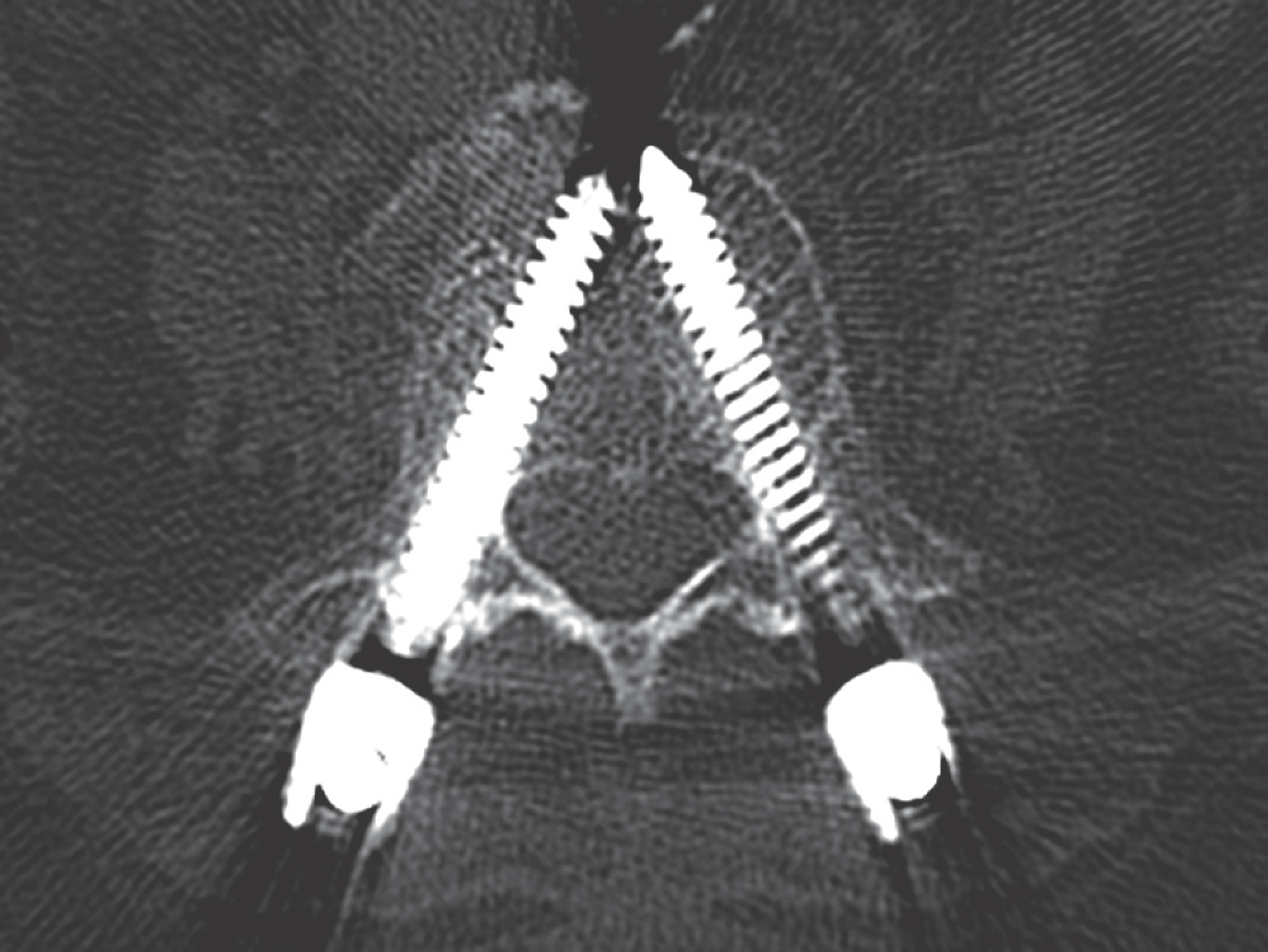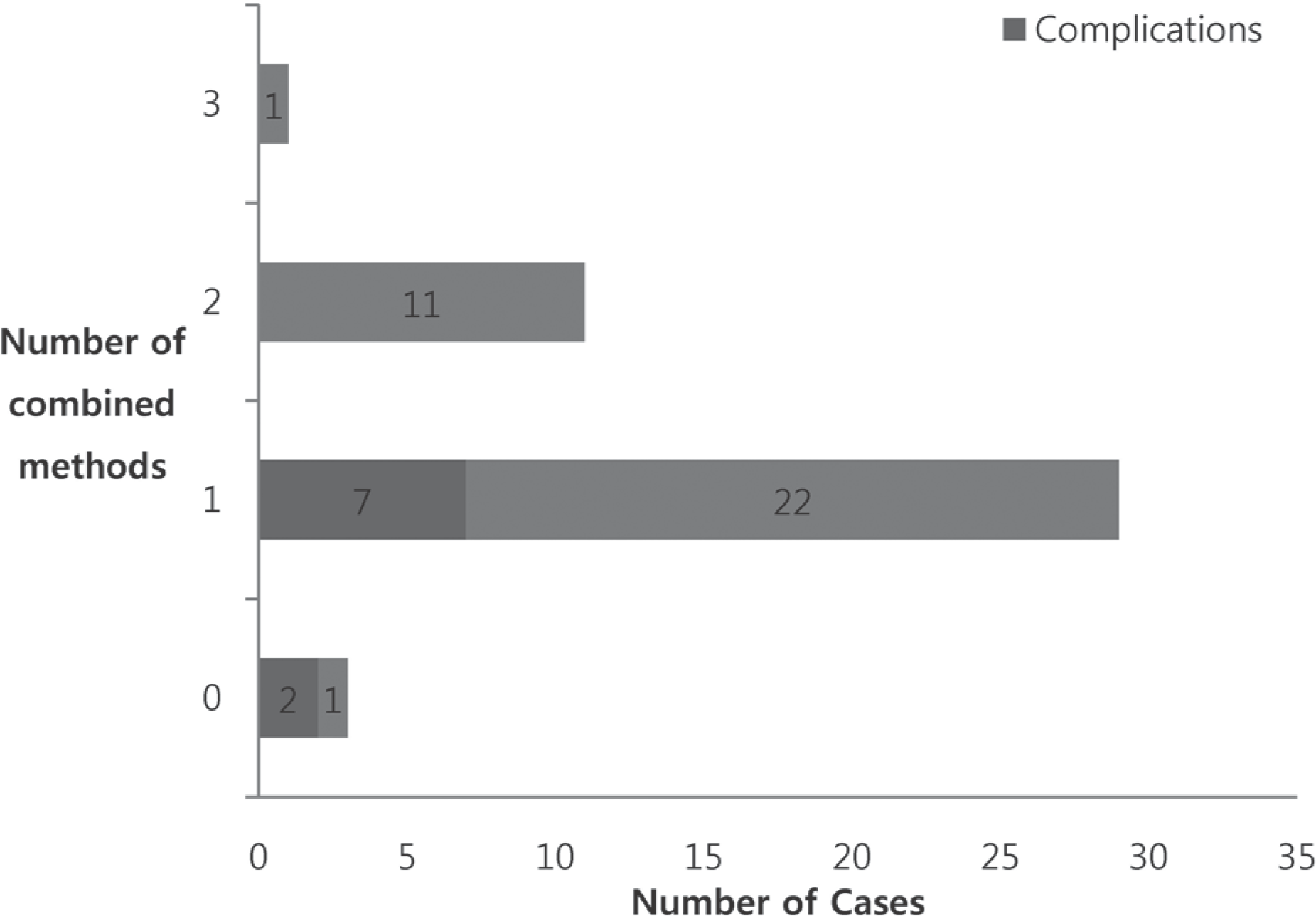Abstract
Objectives
To analyze the clinical results of patients who were treated by pedicle screw fixation in osteoporotic spine and suggest the methods for preventing a loss of fixation strength.
Summary of Literature Review
There are some methods to decrease failure rate and increase fixation strength in the osteoporotic spine: use bicortical screw, cement augmentation and supporting anterior column by interbody fusion using cages.
Materials and Methods
Forty-four patients treated by spinal instrumentation using pedicle screw from 2004 to 2011 were followed for at least 12 months. Five men and 39 women were diagnosed as osteoporotic spine (T score <-3.0). Two hundred forty eight pedicle screws were included and statistically analyzed the correlation between the use of bicortical screw, cement augmentation, anterior column support and fixation loss of the pedicle screw. Radiologic results were evaluated to find out the mechanical complications, like loosening of the screw, fixation failure, and nonunion.
Results
There were 9 complications associated with mechanical strength, loosening of pedicle screws in 7, sinking down of cage in 4, and nonunion in 4 cases. Using bicortical pedicle screw, cement augmentation and anterior column support were significantly correlated with the increasing fixation strength (P=0.001, P=0.047, P=0.014). In addition, these three factors contribute to stabilize the instrumentation (Linear by linear association, P=0.012).
Go to : 
REFERENCES
1.Wu ZX., Cui G., Lei W, et al. Application of an expandable pedicle screw in the severe osteoporotic spine: a preliminary study. Clin Invest Med. 2010. 33:E368–74.

2.Park SB., Chung CK. Strategies of spinal fusion on osteoporotic spine. J Korean Neurosurg Soc. 2011. 49:317–22.

3.Cavagna R., Tournier C., Aunoble S, et al. Lumbar decom-pression and fusion in elderly osteoporotic patients: a pro-spective study using less rigid titanium rod fixation. J Spinal Disord Tech. 2008. 21:86–91.

4.Kang SH., Kim KT., Park SW., Kim YB. A case of pedicle screw loosening treated by modified transpedicular screw augmentation with polymethylmethacrylate. J Korean Neurosurg Soc. 2011. 49:75–8.

5.Amendola L., Gasbarrini A., Fosco M, et al. Fenestrated pedicle screws for cement-augmented purchase in patients with bone softening: a review of 21 cases. J Orthop Traumatol. 2011. 12:193–9.

6.Wu ZX., Gao MX., Sang HX, et al. Surgical Treatment of Osteoporotic Thoracolumbar Compressive Fractures with Open Vertebral Cement Augmentation of Expandable Pedicle Screw Fixation: A Biomechanical Study and a 2-Year Follow-up of 20 Patients. J Surg Res. 2012. 173:91–8.

7.Luk KD., Chen L., Lu WW. A stronger bicortical sacral pedicle screw fixation through the s1 endplate: an in vitro cyclic loading and pull-out force evaluation. Spine (Phila Pa 1976). 2005. 30:525–9.
8.Lee JC., Cha JS., Song HY., Kim YL., Shin BJ. Posterior lumbar interbody fusion using titanium cages and mor-selized local bone autograft. J of Korean Soc Spine Surg. 2006. 13:284–91.

9.Pfeifer BA., Krag MH., Johnson C. Repair of failed trans-pedicle screw fixation. A biomechanical study comparing polymethylmethacrylate, milled bone, and matchstick bone reconstruction. Spine (Phila Pa 1976). 1994. 19:350–3.
10.Wittenberg RH., Lee KS., Shea M., White AA 3rd., Hayes WC. Effect of screw diameter, insertion technique, and bone cement augmentation of pedicular screw fixation strength. Clin Orthop Relat Res. 1993. 278–87.

11.Zindrick MR., Wiltse LL., Widell EH, et al. A biomechanical study of intrapeduncular screw fixation in the lumbosacral spine. Clin Orthop Relat Res. 1986. 99–112.

12.Brantley AG., Mayfield JK., Koeneman JB., Clark KR. The effects of pedicle screw fit. An in vitro study. Spine (Phila Pa 1976). 1994. 19:1752–8.
13.Burval DJ., McLain RF., Milks R., Inceoglu S. Primary pedicle screw augmentation in osteoporotic lumbar vertebrae: biomechanical analysis of pedicle fixation strength. Spine (Phila Pa 1976). 2007. 32:1077–83.
14.Krappinger D., Kastenberger TJ., Schmid R. [Augmented posterior instrumentation for the treatment of osteopo-rotic vertebral body fractures]. Oper Orthop Traumatol. 2012. 24:4–12.
15.Dick W. The “fixateur interne” as a versatile implant for spine surgery. Spine (Phila Pa 1976). 1987. 12:882–900.
16.Magerl FP. Stabilization of the lower thoracic and lumbar spine with external skeletal fixation. Clin Orthop Relat Res. 1984. 125–41.

17.Roy-Camille R., Saillant G., Mazel C. Internal fixation of the lumbar spine with pedicle screw plating. Clin Orthop Relat Res. 1986. 7–17.

18.McAfee PC., DeVine JG., Chaput CD, et al. The indications for interbody fusion cages in the treatment of spon-dylolisthesis: analysis of 120 cases. Spine (Phila Pa 1976). 2005. 30:S60–5.
19.Keppler L SA., Biscup RS. Posterior lumbar intervody fusion with variable screw placement and ISOLA instrumentation. 1997.
20.Oda I., Abumi K., Yu BS., Sudo H., Minami A. Types of spinal instability that require interbody support in posterior lumbar reconstruction: an in vitro biomechanical investigation. Spine (Phila Pa 1976). 2003. 28:1573–80.
21.Na HY., Jeong YY., Kim WS., Cho HW. Surgical Treatment of Isthmic Spondylolisthesis: Pedicle Screw Fixation, Pos-terolateral Fusion, and Posterior Lumbar Interbody Fusion with Cage after Wide Decompression. Journal of Korean Spine Surg. 2003. 10:119–26.

22.Jiang L., Arlet V., Beckman L., Steffen T. Double pedicle screw instrumentation in the osteoporotic spine: a biomechanical feasibility study. J Spinal Disord Tech. 2007. 20:430–5.
Go to : 
 | Fig. 1.Axial CT scan shows bicortical screw fixation purchasing through anterior cortex of vertebral body. |
 | Fig. 3. (A)A 73 year-old woman underwent interbody fusion at L4-5 level in another hospital. (B) Bilateral foraminal stenosis and spinal canal narrowing occurred at L3-4 level. (C) We performed posterior lumbar interbody fusion using cages and pedicle screws at L3-4 level. (D, E) After 8 months, fixation loss of screw occurred at the left side of L3 pedicle. (F) Revisional surgery was performed using bicortical long pedicle screws. |
Table 1.
Complications associated with mechanical strength.
| Case No. | Loosening of Screw | Nonunion | Cage Subsidence |
|---|---|---|---|
| 1 | + | + | + |
| 2 | + | + | |
| 3 | + | + | |
| 4 | + | + | |
| 5 | + | + | + |
| 6 | + | + | |
| 7 | + | ||
| 8 | + | + | |
| 9 | + | + |
Table 2.
Data shows the relationship between screw loosening and methods of fixation.




 PDF
PDF ePub
ePub Citation
Citation Print
Print



 XML Download
XML Download